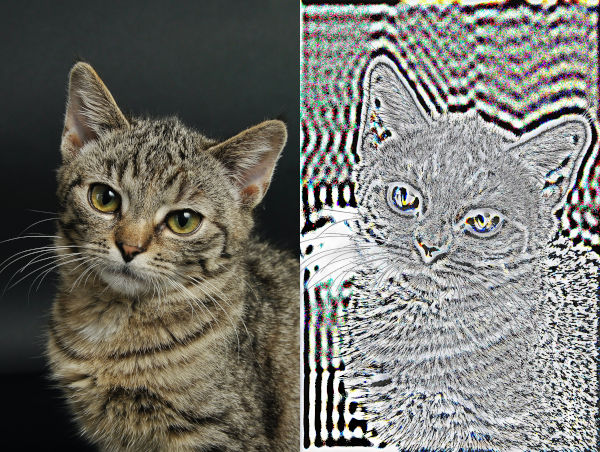An authentic picture of Joseph Fourier’s cat from the 1800s, provided by shoddy computer vision.

The profile icon I use on this website and most sites are generated with a broken program. It has a bug which produces nice looking results. Is it really a bug then?
The original intention of this script is to explore compressing images by removing low-frequency noise from images. The main idea is that when we look at images we care about the details, which is the high-frequency information. So the program does some mapping between spatial and frequency domains thanks to good ol’ Fourier who we fondly remember from our calculus classes.
Kudos to you if you find the bug. You did good. I think it’s better with the bug, so please no squashing :^)
Install: python3 -m pip install numpy opencv-python
ft-fun.py
#!/usr/bin/env python3
import argparse
from os.path import isfile, basename, join, dirname
from cv2 import imread, IMREAD_COLOR, imwrite
import numpy as np
from numpy.fft import fftshift, fft2, ifft2, ifftshift
parser = argparse.ArgumentParser()
parser.add_argument("-f", required=True, type=str, metavar="<file path>", help="Input file")
parser.add_argument("-w", required=False, default=100, type=int, metavar="<int>", help="Width")
args = parser.parse_args()
assert args.f is not None, "Need to give input file with -f"
assert isfile(args.f), "Input file does not exist or is not a file"
f_parts = basename(args.f).split(".")
out_path = join(dirname(args.f), f"{f_parts[0]}-ft-fun-{args.w}-ft-fun.{'.'.join(f_parts[1:])}")
img = np.ndarray.astype(imread(args.f, IMREAD_COLOR), dtype=np.double) # bgr >:(
ch = img.shape[0] // 2
cw = img.shape[1] // 2
hw = args.w // 2
out = np.zeros(img.shape)
for chan_idx in range(img.shape[2]):
c = fftshift(fft2(img[:, :, chan_idx] / 256.0))
c[ch - hw : ch + hw, cw - hw : cw + hw] = 0
out[:, :, chan_idx] = np.around(np.real(ifft2(ifftshift(c))) * 256.0).astype("uint8")
print(f"Writing to {out_path}")
imwrite(out_path, out)